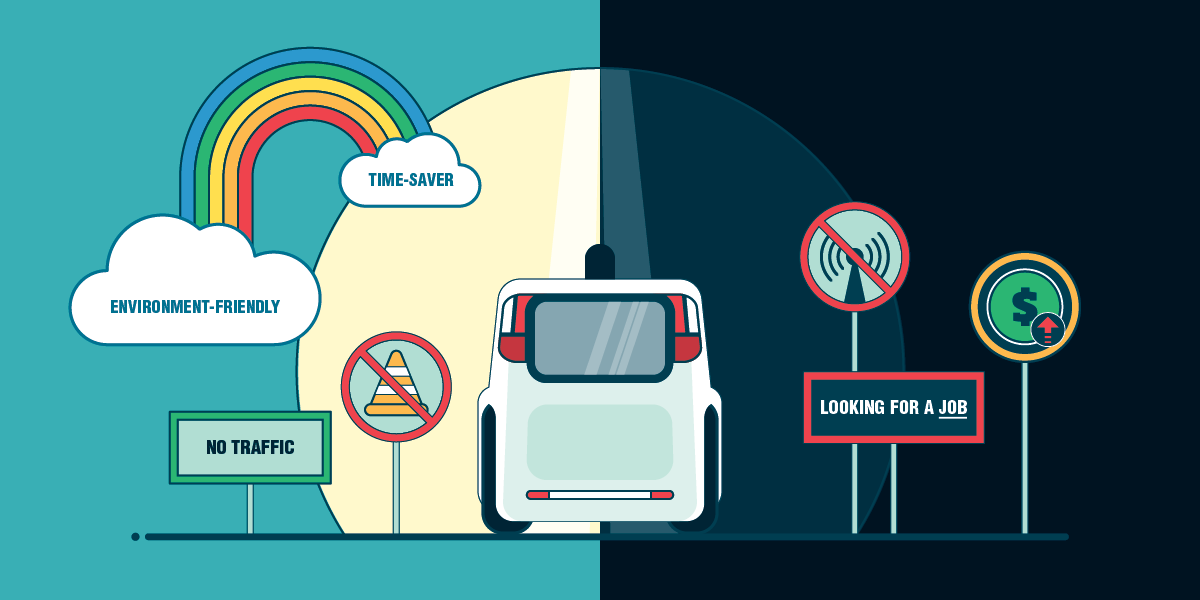Legend has it there once was a driver who didn’t get upset or tired, didn’t drink and drive, didn’t text and drive, and didn’t produce emissions. Too good to be true, and there’s more to come. Imagine not being stuck in traffic, ever, not waiting for a parking spot, and being able to go anywhere by car, no matter what age are you or what disabilities you’re facing. All that and more is planned to become a reality thanks to self-driving cars technology. The autonomous vehicles should enable us to have a future with zero crashes, zero congestion, and zero emissions. That became a greatly talked-about innovation in the automotive industry.
Technology game levels, players and obstacles
When it comes to autonomous technology, there are 5 levels of automation that vehicles can reach – from no automation whatsoever to the level where all aspects of dynamic driving are controlled by the system. The system should be capable of reacting under all roadway and environmental circumstances known to human driver. A lot of hard work is still ahead of the automotive industry in order to present us with self-driving cars satisfying level 5 criteria. These days AI is battling obstacles that lead to level 4. Let’s see how’s that going.
Luminar and Tesla
Making Lidar is one of the main challenges of Austin Russell’s company Luminar, which announced a collaboration with Volvo. Lidar is actually a laser which is used to measure the distance between objects, and it is a key technology that facilitates self-driving cars to maneuver safely in complex traffic surroundings at higher speeds. What differs Luminar from other competitors in the industry is the development of its own lidar sensor technology with the aim to produce better sensors than its competition.
The one disagreeing with using lidar sensor in automated driving technology is Elon Musk, whose Teslas are based on full self-driving hardware, combining radar, cameras and ultrasonics, which provide ’’a safety level substantially greater than that of a human driver," as declared on their website. Still, further software improvements and regulations are needed to get a completely autonomous car. In fact, Tesla self-driving vehicle was recently involved in a crash with fatal outcome. It is the first case of a human killed by a self-driving vehicle. Seems Musk must try even harder.
None of the players in this game of innovation has reached level 5 so we could say ’’We have a winner!’’, but there are some which stand out.
Waymo and GT
Waymo, a part of Google’s parent company, Alphabet Inc., has built several car models with self-driving equipment, such as Lexus RX450h, Toyota Prius, Chrysler Pacifica and Audi TT. Pacifica minivan is equipped with sensors which can see hundreds of yards in any direction – seriously big accomplishment. This company’s autonomous vehicles already have over 5 million road-miles under their wheels and billions in computer simulation. Provoked by Waymo`s progress, their biggest competitor, General Motors needs to hurry with their plans for a ride-sharing service using Chevrolet Bolt. No steering-wheel-and-no-pedals Chevrolet is planned for the end of 2019, while other players are cautious when it comes to announcements, most of them predicting big reveals happening in 2020.
Latest news from GM say that Cadillac is going to expand the use of Super Cruise, the first ever hands-free driver assistance option for the freeway, on all its models. The important thing is that even with a feature like Super Cruise, and similar, driver must not hold his phone or drink, but be focused and capable of taking over the control at any time. You thought you’ll be able to take a nap? Not really.
What is certain is the fact that many of the companies in automotive field have developed great systems, some even extraordinary, however it’s a long and complicated way until the era of invisible, calm, non-swearing computer drivers. Therefore, we have plenty of time to think about self-driving cars pros and cons.
What’s in it for ordinary people?
Potentially good stuff:
- Substantial decrease of traffic accidents, injuries and fatal outcomes. Human errors would be eliminated. We would have saver traffic.
- No more `Sorry, I’ll be late, I’m stuck in traffic.` or `I can’t find a parking space, go in without me.` type of situations. The car would drop you off and return to pick you up. No traffic jams.
- We would have more time for other to-dos, like emails, calls, reading or simply chatting.
- Accidents due to drinking alcohol – zero. Lives saved. Cheers!
- Senior citizens, children, disabled individuals, or exhausted people would no longer depend on others. No more `Honey, please drive my mom to the grocery, give her a ride back, and pick up the kids from practice.`
- No need for everybody to own a car. Less cars, less carbon-dioxide emissions. Healthier environment.
- Not writing tickets all day, police officers would have more time to work on serious crimes.
- And no more `Where are my car keys?!`
Potentially bad stuff:
- The price of this new technology would be, let’s say...high. Out-of-sight high. To adapt the roads, to educate people, to buy a self-driving car. High. At least in the first couple of years of implementation. These days, only the system that drives the car costs 100.000$, plus the price of the vehicle. Companies are intensely working on reducing costs, in order for autonomous cars to be out on the mass market.
- The question of legal responsibility in possible crashes. `Who?Me? I haven’t touched anything!`. Who then?
- Considerable number of jobs lost. Driver job is one of the most common occupation in the world. Other occupations would get affected, too, such as injury layers, driving instructors, insurance agents etc. It could cause an economic disaster.
- Self-driving cars currently depend on GPS. Not all countries have a reliable GPS. If a signal is blocked, it would affect the vehicle’s functioning.
- These cars can do well under average weather condition, but they can’t handle harsh ones, and we all know how unpredictable nature has become.
- Hackers. They always love to intervene. Being operated by a computer system makes autonomous vehicles vulnerable to the bad guys.
- Testing, testing, and more testing. AI is still in the experimental stage of creating a fully autonomous car. Nothing is definite, nothing is perfect and secure. Technology is still being developed and experts are skeptical.
- Does anybody thinks about the people who actually love to drive?
Auto-future
Lots of promises, ideas, visions, but also fears, experiments, doubt. What we must be aware of is the fact that we can enjoy the benefits of self-driving cars only after they had been fully adopted. “It’s a lot of blood, sweat and tears, a lot of all-nighters," says Russell from Luminar, and it cannot be closer to the truth. If all goes as planned, the automotive revolution in its full potential could happen in 5 to 10 years. By that time bees will be saved, people will print their houses, 5G network will rule, and who knows what more.
Should we look forward or be scared?






